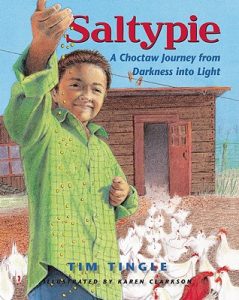Reviewed by Debbie Reese
Review Source: American Indians in Children’s Literature
Book Author: Tim Tingle
Before you read Tim Tingle’s Saltypie to your child or students in your classroom or library, spend some time studying what Tingle says at the end of the book, on the pages titled “How Much Can We Tell Them?”
There, you’ll learn a little about Tim’s childhood, and some about his father, grandmother, the Choctaw Nation, and, the rock-throwing incident in the book. Here’s an excerpt:
I always knew we were Choctaws, but as a child I never understood that we were Indians. The movies and books about Indians showed Indians on horseback. My family drove cars and pickup trucks. Movie Indians lived in teepees. We lived in modern houses. Indians in books and on television hunted with bows and arrows. My father and my uncles hunted, too, with shotguns, but mostly they fished.
I have similar memories of my own. I watched the Indians on television and thought they weren’t really Indians. I knew that we were Pueblo Indians, but we didn’t look or live anything at all like the ones on TV, so I figured they weren’t real. Tingle’s note has a lot of very powerful information in it:
We know our history never included teepees or buffaloes. We were people of the woods and swamps of what is now called Mississippi. Early Choctaws had gardens and farms. For hundreds of years, they lived in wooden houses.
and
Long before explorers arrived from Europe, we had a government, a Choctaw national government. We selected local and national leaders. We recognized women as equal citizens.
Did you do a double take as you read his words? I bet your students will! Indian people — prior to Europeans arrival on the continent that came to be known as North America — had governments?! Women were equal citizens?!! Those are powerful and important words for you (the adult) to carry with you every single time you pick up a book that has American Indians in it. We weren’t primitive. We weren’t savage. Continue reading American Indians in Children’s Literature.

Saltypie by Tim Tingle
Published by Cinco Puntos Press on January 1, 2014
Genres: American Indians First Nations Metis Inuit, Grandparents and Elders, Racial Identity
Pages: 40
Reading Level: Grades 1-2, Grades 3-5
ISBN: 9781935955184
Review Source: American Indians in Children's Literature
Publisher's Synopsis:
Bee stings on the backside! That was just the beginning. Tim was about to enter a world of the past, with bullying boys, stones and Indian spirits of long ago. But they were real spirits, real stones, very real memories…
In this powerful family saga, author Tim Tingle tells the story of his family’s move from Oklahoma Choctaw country to Pasadena, TX. Spanning 50 years, Saltypie describes the problems encountered by his Choctaw grandmother — from her orphan days at an Indian boarding school to hardships encountered in her new home on the Gulf Coast.
Tingle says, “Stories of modern Indian families rarely grace the printed page. Long before I began writing, I knew this story must be told.” Seen through the innocent eyes of a young boy, Saltypie — a 2011 Skipping Stones honor book, WordCraft Circle 2012 Children's Literature Award-winner, and winner of the 2011 Paterson Prize for Books for Young People in the category of Grades 4-6 — is the story of one family’s efforts to honor the past while struggling to gain a foothold in modern America.
Tim Tingle, a member of the Choctaw Nation of Oklahoma, is a sought-after storyteller for folklore festivals, library conferences, and schools across America. At the request of Choctaw Chief Pyle, Tim tells a story to the tribe every year before Pyle’s State of the Nation Address at the Choctaw Labor Day Gathering. Tim’s previous and often reprinted books from Cinco Puntos Press—Walking the Choctaw Road and Crossing Bok Chitto—received numerous awards, but what makes Tim the proudest is the recognition he receives from the American Indian communities.
Karen Clarkson, a Choctaw tribal member, is a self-taught artist who specializes in portraits of Native Americans. She did not start painting until after her children had left home; she has since been widely acclaimed as a Native American painter. She lives in San Leandro, California.

Leave a Reply